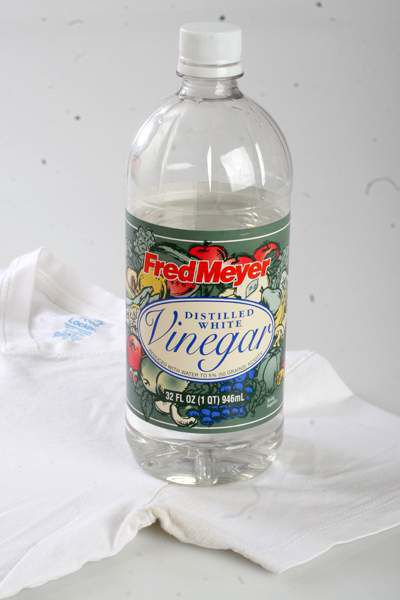Dont let sweat ruin your style
Published 5:00 am Wednesday, August 13, 2008

- Applying vinegar and water to a T-shirt can help remove a sweat stain.
We’ll answer your questions and share your tips. Send them to shopper@bendbulletin.com.
Q: I have a problem with dark underarm stains on my shirts, both white and colored. Is there anything I can do to stop ruining my clothes?
Trending
A: Sweat has been an enemy of clothing since, well, forever. Close-fitting tops and certain fabrics, like silk or satin, show sweat stains more than others.
Before you start scrubbing your shirts with vinegar or baking soda (stay away from bleach!), consider some ways to prevent these stains from forming in the first place.
First, what is making the stain: your sweat or your deodorant?
If the stain is yellow or greenish with a crisp texture, it’s from perspiration. If the stain is white, clear and greasy-looking, it’s from the antiperspirant, which should be cleaned like any other grease stain (apply a spot remover and wash with cold water).
Now, consider your antiperspirant, which works by blocking sweat glands from opening (deodorant simply masks odor).
Some over-the-counter antiperspirants are so full of metals like aluminum that they can discolor your clothing, so try changing deodorants to find what works best for you. Perhaps a more natural deodorant is the right choice? If you use a liquid deodorant, make sure it has completely dried before coming into contact with your clothes.
Trending
Also, try wearing cheap T-shirts or tank tops under your dress shirts. They can protect your clothes and cost a couple of bucks at apparel stores. You can wear them at least one season and then toss them.
Some basic tips from Redmond, Wash.-based cleaning service Mrs. Clean and Mike Ramsey’s book, “Stop Sweating and Start Living” (www.sweat cure.com):
• Do not iron a shirt stain because that will fuse the stain to the fabric.
• The longer you leave a sweat-stained shirt dirty, the more likely the stain won’t come out. Try washing it within two days of wearing it.
Why we sweat
Sweating occurs to maintain the body’s temperature and keep skin cool and hydrated. Two basic kinds of sweating exist: emotional sweating and thermal sweating, according to Bend Memorial Clinic endocrinologist Mary Carroll.
No dietary factors are known to affect the amount you sweat, Carroll said.
Emotional sweating often happens with social anxiety and makes the hands and feet sweaty. Thermal sweating happens during exercise.
Both of these are normal, Carroll says, as is sweating while you eat. However, some people have excessive sweating, called hyperhydrosis, that impairs their professional and personal life.
Hyperhydrosis usually develops in teenagers, Carroll said, and is commonly a condition that runs in the family. Treatment includes prescription-strength antiperspirants, Botox injections and, in extreme cases, surgery to sever the nerve in your chest that stimulates sweat glands, Carroll said.
The Botox treatment is often covered by insurance, Carroll said, and blocks the neurologic signal to sweat glands, making you sweat less. However, it is painful.
For emotional sweating, Carroll said many patients find that anti-anxiety medications help.
Home remedies
So now that you’ve decided a shirt is worth salvaging, your stain-removal solution is probably sitting in your cleaning closet.
Remember that sweat is a protein and some chemicals will not react well to it. Avoid chlorine bleach, which will react badly with the sweat proteins and make the stain darker.
Home-based treatments are better for natural fibers like cotton or linen, so don’t try them with delicate fabrics, including silk and wool, which are best left to professional dry cleaners.
Some inexpensive removal tips:
* Sun: Soak the shirt in water, then apply liquid detergent to the stain. Lay the garment to dry in the sun, spraying the stain with water a few times over a few hours. After a full afternoon of sunbathing, wash with cool water and air dry.
• Hydrogen peroxide: Mix equal amounts of hydrogen peroxide with water and pour onto the stain. Allow it to soak at least 30 minutes, then wash in cool water and air dry. Be careful using this method with colored clothes, as it may discolor the fabric.
• Vinegar and water: Mix one tablespoon of white vinegar with half a cup of water. Soak the shirt in the solution for around 30 minutes, then wash in cool water and air dry.
• Cream of tartar and aspirin: Make a paste with one tablespoon of cream of tartar, three crushed white aspirin tablets and a cup of warm water. Scrub the mixture into the stain with an old toothbrush. Soak for 30 minutes, then rinse until the paste is removed. Repeat as necessary and air dry.
• Baking powder: This can get rid of the sweat smell. Add a half cup of baking soda to your liquid laundry detergent when you are washing the stained clothes. To attack the stain, too, make a paste of baking soda and water, then rub on the stain. Let it sit for 15 to 20 minutes and wash as usual.
The bottom line: If no amount of scrubbing will get rid of your stain, toss the shirt or cut it up for cleaning rags.
— Anna Sowa, The Bulletin








